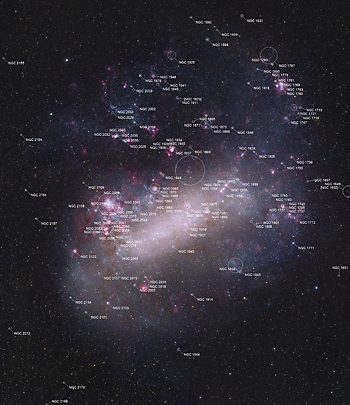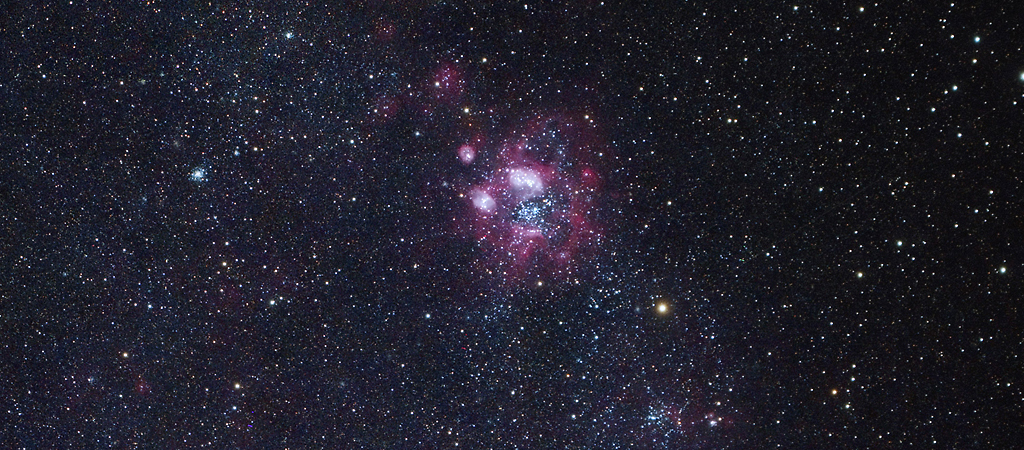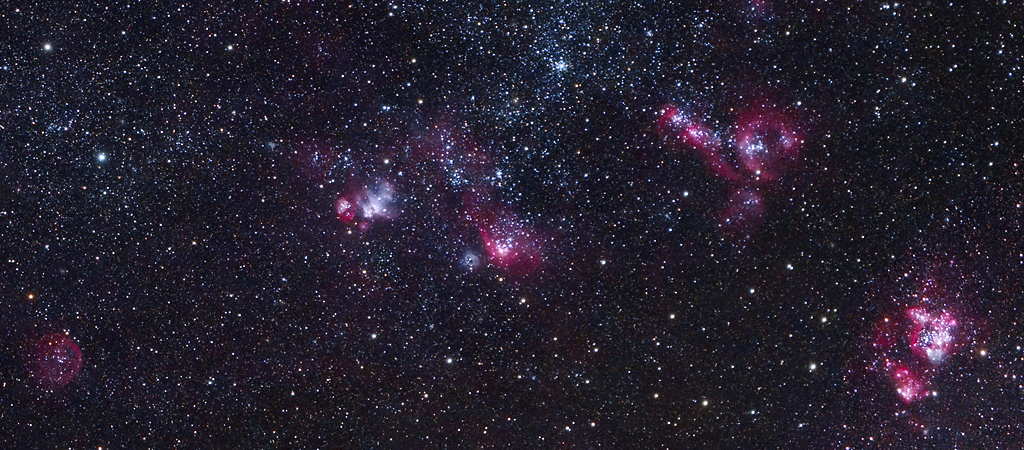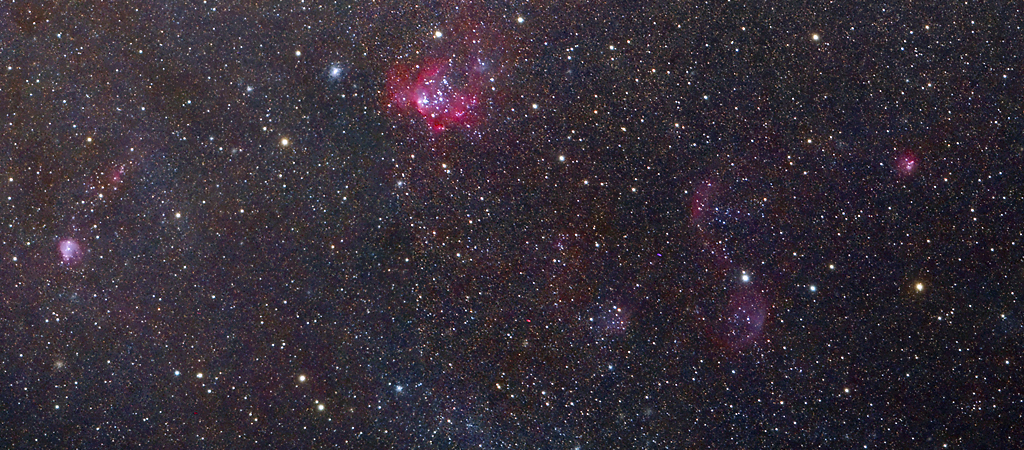 |
CHAMÄLEON + ONJALA OBSERVATORY DeepSky | SITEMAP HOME CHAMÄLEON |
|
 |
|||
| « zurück zur Startseite
Galaxien « back to home galaxies |
Großes Bild laden - load large image 2048 x 1400 Pixel 3500 x 4100 Pixel Aufnahmedaten Image data |
LMC - the Large Magellanic Cloud in a general view

Unser Bild zeigt eine Gesamtansicht der großen Magellanschen Wolke (LMC), bestehend aus 8 Einzelsegmenten, aufgenommen in den Nächten vom 01. bis zum 04. Mai 2022. Das Mosaik überdeckt eine Fläche von etwa 7 x 9 Grad am Himmel, in der Bilddiagonale entspricht da ungefähr 22.000 Lichtjahre. Die Originalgröße des Mosaiks hat 7.200 x 8.350 Pixel, der Abbildungsmaßstab liegt bei ca. 4 Bogensekunden pro Pixel. Bildorientierung: Norden oben und Osten links. Dieses Mosaik ist zweifellos eines unserer "Master pieces". Aufgenommen mit einem Williams Optic RedCat 51 mit 250mm Brennweite. Dieser kleine, aber feine apochromatische Refraktor mit einem Öffnungsverhältnis von f/4.9 kam im Jahr 2022 zum ersten mal zum Einsatz (siehe auch unser Mosaik des Kreuz des Südens zusammen mit dem Kohlensack) und schlägt alle unser Canon Teleobjektive ähnlicher Brennweite in der optischen Qualität um Längen.
Zusammen mit der kleinen Magellanschen Wolke (SMC) sind sie Satellitengalaxien unserer Milchstraße (Galaxis). Die Entfernung der LMC zum Sonnensystem liegt bei knapp 170.000 Lichtjahren. Sie ist das viertgrößte Mitglied der lokalen Gruppe, nur unsere Milchstraße, der Andromedanebel Messier 31 und die Dreieckgalaxie Messier 33 sind größer.
Ihre Namen gehen letztendlich auf den spanischen Seefahrer Ferdinand Magellan zurück. Bis ins 19. Jahrhundert waren beide Galaxien als Kappwolken bekannt, eine Bezeichnung die sich auf Kap Horn, beziehungsweise auf das Kapp der guten Hoffnung bezieht, von wo aus die Galaxien gut sichtbar waren.
Our image shows a general view of the Large Magellanic Cloud (LMC), consisting of 8 individual segments, taken in the nights from 01 to 04 May 2022. The mosaic covers an area of about 8 x 10 degrees in the sky, in the image diagonal this corresponds to about 22,000 light years. The original size of the mosaic is 7,200 x 8,350 pixels, the image scale is about 4 arc seconds per pixel. Image orientation: north top and east left. This mosaic is undoubtedly one of our "master pieces". Taken with a Williams Optic RedCat 51 with 250mm focal length. This small but fine apochromatic refractor with a focal ratio of f/4.9 was used for the first time in 2022 (see also our mosaic of the Southern Cross together with the Coal Sack) and beats all our Canon telephoto lenses of similar focal length in optical quality by far.
Together with the Small Magellanic Cloud (SMC), they are satellite galaxies of our Milky Way (Galaxy). The distance of the LMC from the solar system is just under 170,000 light years. It is the fourth largest member of the local group, only our Milky Way, the Andromeda Nebula Messier 31 and the Triangulum Galaxy Messier 33 are larger.
Their names ultimately go back to the Spanish navigator Ferdinand Magellan. Until the 19th century, both galaxies were known as the Cape Clouds, a name that refers to Cape Horn, or the Cape of Good Hope, from where the galaxies were clearly visible.
 |
Weitere Bilder mit detaillierten Beschreibungen von uns: Die kleine
Magellansche Wolke
zeigen wir hier. Den Kernbereich der großen
Magellanschen Wolke - NGC 2070, den Tarantelnebel -
zeigen wir hier. Professionelle Bilder: Eine vergleichbare Aufnahme der ESO mit Objektbezeichnungen, aufgenommen mit dem 2.2 Meter Teleskop finden Sie hier. Den Kernbereich des Tarantelnebels mit dem offenen Sternhaufen R 136 a, aufgenommen mit dem Very Large Telescope der ESO finden Sie hier. More images with detailed descriptions from us: We show the Small Magellanic Cloud here. The core area of the Large Magellanic Cloud - NGC 2070, the Tarantula Nebula - we show here. Professional images: A comparable image from ESO with object annotations, taken with the 2.2 metre telescope can be found here. The core region of the Tarantula Nebula with the open star cluster R 136 a, taken with ESO's Very Large Telescope can be found here. « Hier oder auf das Vorschaubild zum Laden eines großen Bildes mit Objektbezeichnungen klicken. « Click here or on the thumbnail to load a large image with object annotations. Drei der Objekte in der großen Magellanschen Wolke haben Eigennamen: NGC 2032 = Dragon´s Head, NGC 1760-63 = Bean Nebel und NGC 2070 = Tarantula Nebel. Three of the objects in the Large Magellanic Cloud have specific names: NGC 2032 = Dragon's Head, NGC 1760-63 = Bean Nebula and NGC 2070 = Tarantula Nebula. |
The following 3 images are intended to demonstrate the high optical imaging quality of the Williams Redcat. They are sections in a size of 50% of the original mosaic and show from top to bottom the regions around NGC 1763, NGC 2020 and NGC 2018.



The Large Magellanic Cloud in a general view
Image data
01. - 04.05.2022 - 6 x 600 + 2 x 300 sec, ASI ZWO 071 ProC (cooled to - 10 degrees) - mosaic of 8 segments
Telescope: Williams RedCat - f = 250mm -f/5
Location: Chamäleon Observatory, Onjala Lodge, Namibia
Image processing: DeepSkyStacker and Photoshop
 |
 |
 |
 |
 |
 |
 |
| Sonne | Mond | Sonnensystem | DeepSky | Weitwinkel | Verschiedenes | Spez. Projekte |